Commensurability is the property of two orbiting objects, such as planets, satellites, or asteroids, whose orbital periods are in a rational proportion.
Examples include the 2:3 commensurability between the orbital periods of Neptune and Pluto, [1] the 3:4 commensurability between the orbital periods of the Saturnian satellites Titan and Hyperion, [2] the orbital periods associated with the Kirkwood gaps in the asteroid belt relative to that of Jupiter, [3] and the 2:1 commensurability between Gliese 876 b and Gliese 876 c.
Commensurabilities are normally the result of an orbital resonance, rather than being due to coincidence.
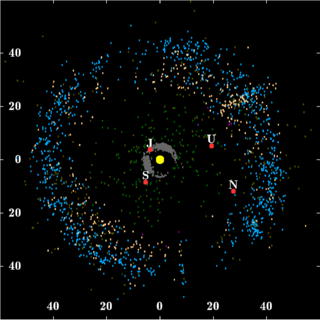
The Kuiper belt is a circumstellar disc in the outer Solar System, extending from the orbit of Neptune at 30 astronomical units (AU) to approximately 50 AU from the Sun. It is similar to the asteroid belt, but is far larger—20 times as wide and 20–200 times as massive. Like the asteroid belt, it consists mainly of small bodies or remnants from when the Solar System formed. While many asteroids are composed primarily of rock and metal, most Kuiper belt objects are composed largely of frozen volatiles, such as methane, ammonia, and water. The Kuiper belt is home to most of the objects that astronomers generally accept as dwarf planets: Orcus, Pluto, Haumea, Quaoar, and Makemake. Some of the Solar System's moons, such as Neptune's Triton and Saturn's Phoebe, may have originated in the region.
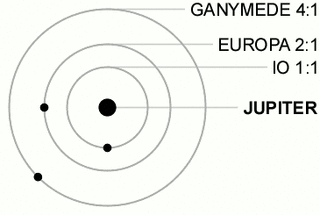
In celestial mechanics, orbital resonance occurs when orbiting bodies exert regular, periodic gravitational influence on each other, usually because their orbital periods are related by a ratio of small integers. Most commonly, this relationship is found between a pair of objects. The physical principle behind orbital resonance is similar in concept to pushing a child on a swing, whereby the orbit and the swing both have a natural frequency, and the body doing the "pushing" will act in periodic repetition to have a cumulative effect on the motion. Orbital resonances greatly enhance the mutual gravitational influence of the bodies. In most cases, this results in an unstable interaction, in which the bodies exchange momentum and shift orbits until the resonance no longer exists. Under some circumstances, a resonant system can be self-correcting and thus stable. Examples are the 1:2:4 resonance of Jupiter's moons Ganymede, Europa and Io, and the 2:3 resonance between Neptune and Pluto. Unstable resonances with Saturn's inner moons give rise to gaps in the rings of Saturn. The special case of 1:1 resonance between bodies with similar orbital radii causes large solar system bodies to eject most other bodies sharing their orbits; this is part of the much more extensive process of clearing the neighbourhood, an effect that is used in the current definition of a planet.

A planet is a large, rounded astronomical body that is neither a star nor its remnant. The best available theory of planet formation is the nebular hypothesis, which posits that an interstellar cloud collapses out of a nebula to create a young protostar orbited by a protoplanetary disk. Planets grow in this disk by the gradual accumulation of material driven by gravity, a process called accretion. The Solar System has at least eight planets: the terrestrial planets Mercury, Venus, Earth and Mars, and the giant planets Jupiter, Saturn, Uranus and Neptune. These planets each rotate around an axis tilted with respect to its orbital pole. All planets of the Solar System other than Mercury possess a considerable atmosphere, and some share such features as ice caps, seasons, volcanism, hurricanes, tectonics, and even hydrology. Apart from Venus and Mars, the Solar System planets generate magnetic fields, and all except Venus and Mercury have natural satellites. The giant planets bear planetary rings, the most prominent being those of Saturn.
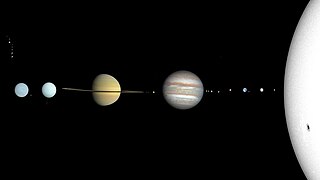
The Solar System is the gravitationally bound system of the Sun and the objects that orbit it. The largest of such objects are the eight planets, in order from the Sun: four terrestrial planets named Mercury, Venus, Earth and Mars, two gas giants named Jupiter and Saturn, and two ice giants named Uranus and Neptune. The terrestrial planets have a definite surface and are mostly made of rock and metal. The gas giants are mostly made of hydrogen and helium, while the ice giants are mostly made of 'volatile' substances such as water, ammonia, and methane. In some texts, these terrestrial and giant planets are called the inner Solar System and outer Solar System planets respectively.

Pluto is a dwarf planet in the Kuiper belt, a ring of bodies beyond the orbit of Neptune. It is the ninth-largest and tenth-most-massive known object to directly orbit the Sun. It is the largest known trans-Neptunian object by volume, by a small margin, but is slightly less massive than Eris. Like other Kuiper belt objects, Pluto is made primarily of ice and rock and is much smaller than the inner planets. Pluto has only one sixth the mass of Earth's moon, and one third its volume.

A terrestrial planet, telluric planet, solid planet, or rocky planet, is a planet that is composed primarily of silicate rocks or metals. Within the Solar System, the terrestrial planets accepted by the IAU are the inner planets closest to the Sun: Mercury, Venus, Earth, and Mars. Among astronomers who use the geophysical definition of a planet, some planetary-mass satellites, e.g. Earth's Moon and Jupiter's Io and sometimes Europa, may also be considered terrestrial planets; and so maybe the rocky protoplanet-asteroids Pallas and Vesta. The terms "terrestrial planet" and "telluric planet" are derived from Latin words for Earth, as these planets are, in terms of structure, Earth-like. Terrestrial planets are generally studied by geologists, astronomers, and geophysicists.

A Kirkwood gap is a gap or dip in the distribution of the semi-major axes of the orbits of main-belt asteroids. They correspond to the locations of orbital resonances with Jupiter.

A natural satellite is, in the most common usage, an astronomical body that orbits a planet, dwarf planet, or small Solar System body. Natural satellites are colloquially referred to as moons, a derivation from the Moon of Earth.

Tidal locking between a pair of co-orbiting astronomical bodies occurs when one of the objects reaches a state where there is no longer any net change in its rotation rate over the course of a complete orbit. In the case where a tidally locked body possesses synchronous rotation, the object takes just as long to rotate around its own axis as it does to revolve around its partner. For example, the same side of the Moon always faces the Earth, although there is some variability because the Moon's orbit is not perfectly circular. Usually, only the satellite is tidally locked to the larger body. However, if both the difference in mass between the two bodies and the distance between them are relatively small, each may be tidally locked to the other; this is the case for Pluto and Charon, as well as for Eris and Dysnomia. Alternative names for the tidal locking process are gravitational locking, captured rotation, and spin–orbit locking.

Hyperion, also known as Saturn VII, is a moon of Saturn discovered by William Cranch Bond, his son George Phillips Bond and William Lassell in 1848. It is distinguished by its irregular shape, its chaotic rotation, and its unexplained sponge-like appearance. It was the first non-round moon to be discovered.
Jack Wisdom is a Professor of Planetary Sciences at the Massachusetts Institute of Technology. He received his B.S. from Rice University in 1976 and his Ph.D. from California Institute of Technology in 1981. His research interests are the dynamics of the Solar System.
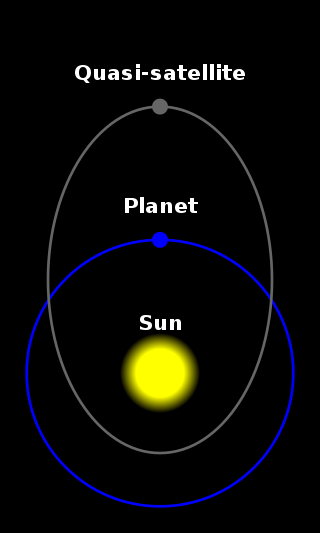
A quasi-satellite is an object in a specific type of co-orbital configuration with a planet where the object stays close to that planet over many orbital periods.

Gliese 876 is a red dwarf approximately 15 light-years away from Earth in the constellation of Aquarius. It is one of the closest known stars to the Sun confirmed to possess a planetary system with more than two planets, after Gliese 1061, YZ Ceti, Tau Ceti, and Luyten's Star; as of 2018, four extrasolar planets have been found to orbit the star. The planetary system is also notable for the orbital properties of its planets. It is the only known system of orbital companions to exhibit a near-triple conjunction in the rare phenomenon of Laplace resonance. It is also the first extrasolar system around a normal star with measured coplanarity. While planets b and c are located in the system's habitable zone, they are giant planets believed to be analogous to Jupiter.

Gliese 876 c is an exoplanet orbiting the red dwarf Gliese 876, taking about 30 days to complete an orbit. The planet was discovered in April 2001 and is the second planet in order of increasing distance from its star.
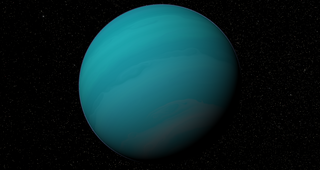
Gliese 876 b is an exoplanet orbiting the red dwarf Gliese 876. It completes one orbit in approximately 61 days. Discovered in June 1998, Gliese 876 b was the first planet to be discovered orbiting a red dwarf.
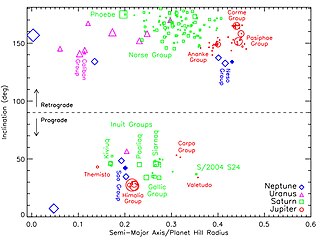
In astronomy, an irregular moon, irregular satellite or irregular natural satellite is a natural satellite following a distant, inclined, and often eccentric and retrograde orbit. They have been captured by their parent planet, unlike regular satellites, which formed in orbit around them. Irregular moons have a stable orbit, unlike temporary satellites which often have similarly irregular orbits but will eventually depart. The term does not refer to shape; Triton for example, is a round moon, but is considered irregular due to its orbit.
The stability of the Solar System is a subject of much inquiry in astronomy. Though the planets have been stable when historically observed, and will be in the short term, their weak gravitational effects on one another can add up in unpredictable ways.

Retrograde motion in astronomy is, in general, orbital or rotational motion of an object in the direction opposite the rotation of its primary, that is, the central object. It may also describe other motions such as precession or nutation of an object's rotational axis. Prograde or direct motion is more normal motion in the same direction as the primary rotates. However, "retrograde" and "prograde" can also refer to an object other than the primary if so described. The direction of rotation is determined by an inertial frame of reference, such as distant fixed stars.

Gliese 876 e is an exoplanet orbiting the star Gliese 876 in the constellation of Aquarius. It is in a 1:2:4 Laplace resonance with the planets Gliese 876 c and Gliese 876 b: for each orbit of planet e, planet b completes two orbits and planet c completes four. This configuration is the second known example of a Laplace resonance after Jupiter's moons Io, Europa and Ganymede. Its orbit takes 124 days to complete.
The jumping-Jupiter scenario specifies an evolution of giant-planet migration described by the Nice model, in which an ice giant is scattered inward by Saturn and outward by Jupiter, causing their semi-major axes to jump, quickly separating their orbits. The jumping-Jupiter scenario was proposed by Ramon Brasser, Alessandro Morbidelli, Rodney Gomes, Kleomenis Tsiganis, and Harold Levison after their studies revealed that the smooth divergent migration of Jupiter and Saturn resulted in an inner Solar System significantly different from the current Solar System. During this migration secular resonances swept through the inner Solar System exciting the orbits of the terrestrial planets and the asteroids, leaving the planets' orbits too eccentric, and the asteroid belt with too many high-inclination objects. The jumps in the semi-major axes of Jupiter and Saturn described in the jumping-Jupiter scenario can allow these resonances to quickly cross the inner Solar System without altering orbits excessively, although the terrestrial planets remain sensitive to its passage.